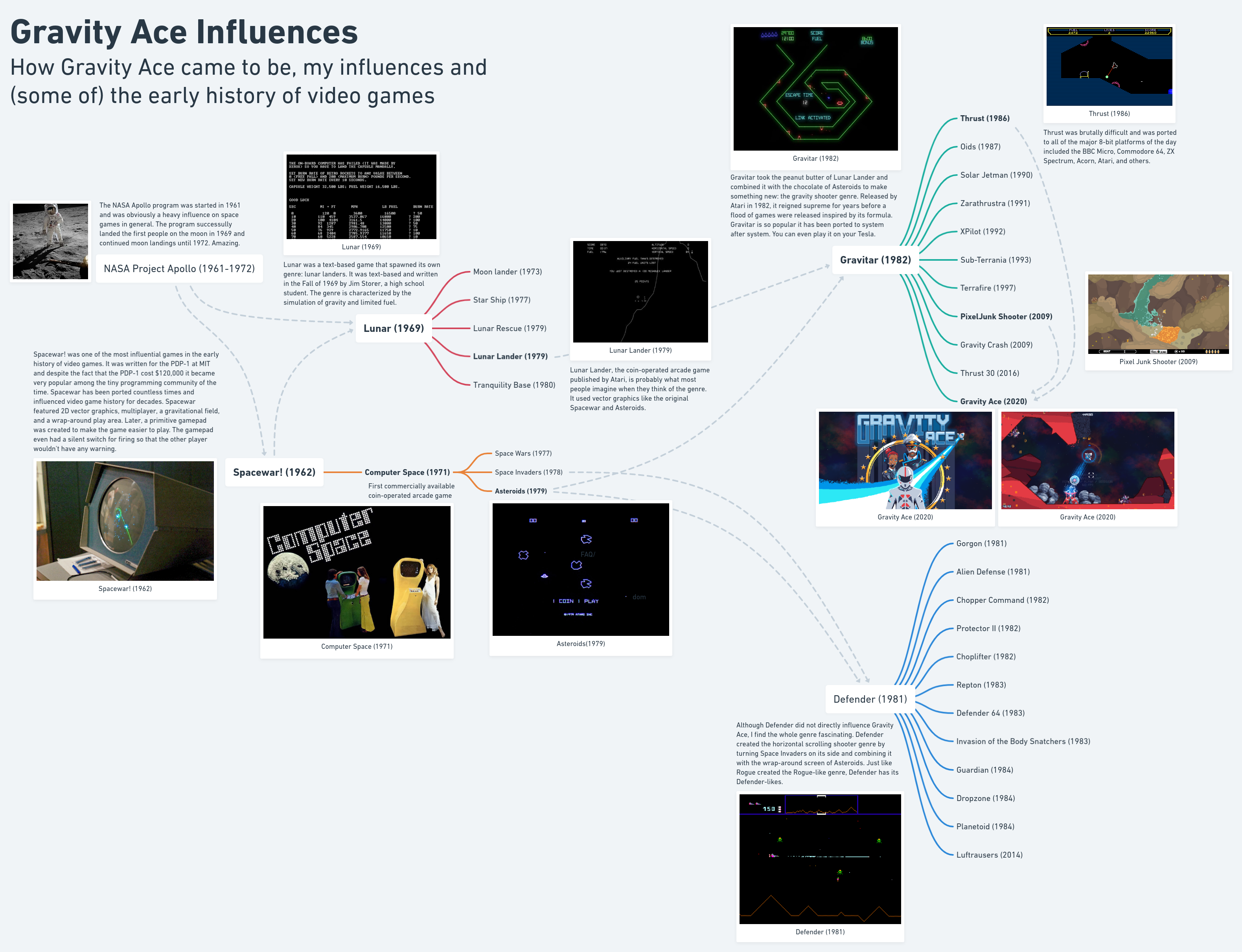History of Thrust-likes and Gravity Ace influences

Gravity Ace Influences
Transcript:
Welcome back, pilots, to another Gravity Ace devlog! This week I wanted to talk a bit about my influences and motivations for creating Gravity Ace.
Now, you can follow a chain of events all the way back to the dawn of time but I’ve only got a few minutes so I’m going to pick an arbitrary starting point: the NASA Apollo Program. Obviously that was influenced by the Cold War and the Space Race but let’s start there.
The Apollo Program was started in 1961. The project successfully landed the first people on the moon in 1969 and continued moon landings until 1972. It was an amazing achievement. It was obviously a heavy influence on space games and the first games were created almost immediately…
Spacewar by Steve Russell, Martin Graetz, and Wayne Wiitanen was created in 1962, just one year after the Apollo program started. And it turned out to be one of the most influential games in the early history of video games. It was written for the PDP-1 at MIT and despite the fact that a PDP-1 cost $120,000 it became very popular among the tiny programming community of the time. Spacewar has been ported countless times and influenced video game history for decades. Spacewar had 2D vector graphics, local multiplayer, a gravitational field, and a wrap-around play area. Later, a primitive gamepad was created to make the game easier to play. The gamepad even had a silent switch for firing so that the other player wouldn’t have any warning.
Lunar, created in 1969, the year people first landed on the moon, was a text-based game that spawned its own genre: lunar landers. The genre is characterized by the simulation of gravity and limited fuel. It was written in the Fall of 1969 by a high school student named Jim Storer. Lunar created the Lunar Lander genre and influenced games like Moon Lander, Star Ship, Lunar Rescue, Tranquility Base, and the landmark Lunar Lander by Howard Delman and Rich Moore. Although not the first, Lunar Lander, published by Atari, is probably what most people imagine when they think of the genre.
Then in the 70s, everything changed with the invention of coin-operated arcade machines. In 1971, Computer Space hit the market, the first commercially available coin-operated arcade game. That was quickly followed by an explosion of games by Atari and others. Spacewar led to fixed and multi-directional shooter games like Space Invaders by Tomohiro Nishikado) and Asteroids (and later, Defender and Defender-likes).
Lunar Lander and Asteroids — by Lyle Rains, Ed Logg, and Dominic Walsh — were both released in 1979. Then, in 1982, Gravitar was born. Gravitar — by Mike Hally, Rich Adam, and Joe Coddington — took the peanut butter of Lunar Lander and combined it with the chocolate of Asteroids to make something new: the gravity shooter genre. Released by Atari, it reigned supreme for years and its influence can be felt to this day. Gravitar is so popular it has been ported to system after system… You can even play it on your Tesla.
Gravitar inspired a flood of games including Thrust by Jeremy Smith, Oids, Solar Jetman, Zarathrustra, XPilot, Sub-Terrania, Terrafire, PixelJunk Shooter, Gravity Crash, Thrust 30, and of course, Gravity Ace.
I remember dropping many quarters into Gravitar. And Thrust was one of my favorite games on my Commodore 64. Years later, I got the strong urge to play Thrust again and Gravity Ace was born. I never player Oids or Solar Jetman or the others. But Thrust, PixelJunk Shooter, and Gravitar all heavily influenced the creation of Gravity Ace.
Thanks for watching this short history lesson. Please remember to tell your friends about Gravity Ace, follow me on Twitter, wishlist it on steam, and go to Gravity Ace dot com for a link to my Discord server.
Thanks for watching and see you next time!
Published July 6, 2020
